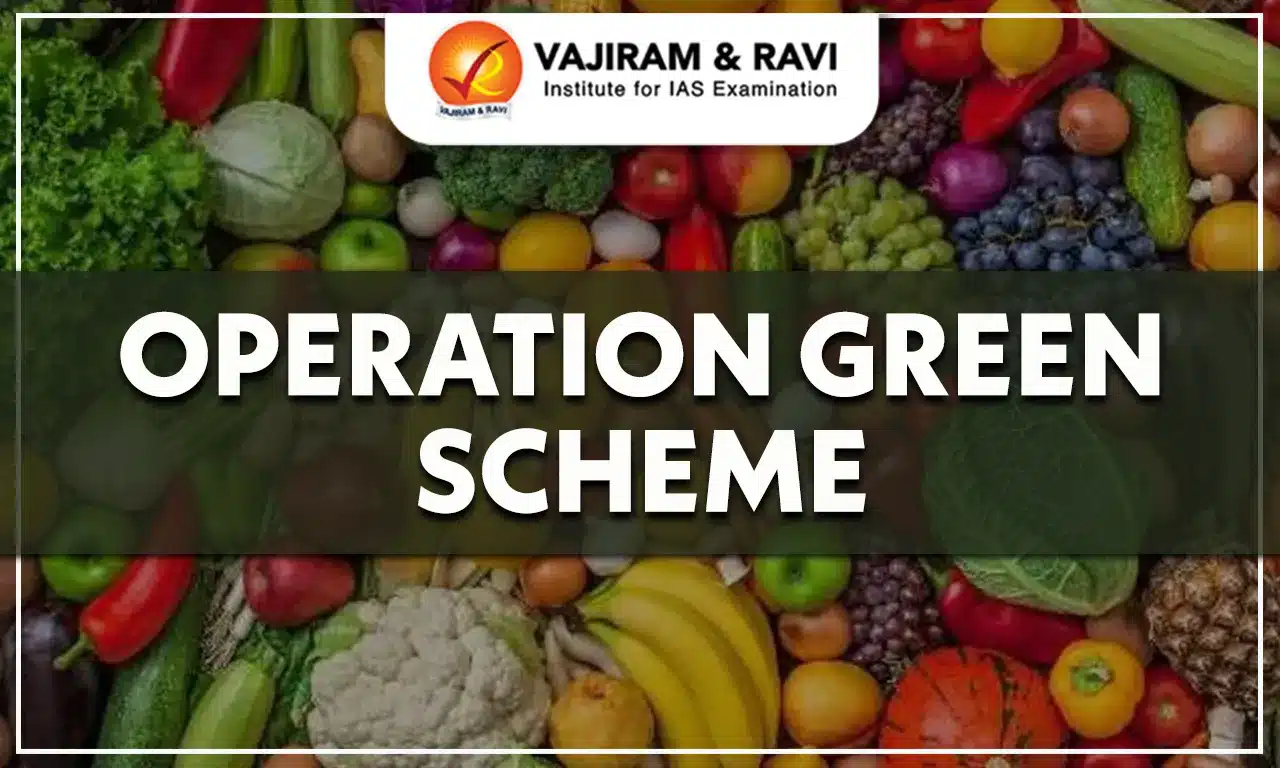Operation Green Scheme was launched by the Government of India in 2018. The scheme focuses on the short term and long term interventions of Tomato, Onion and Potato value chain.
Through this initiative the aim is to boost the production and supply of fruits, vegetables and other perishable agricultural commodities. The scheme is implemented in two parts, one under Atmanirbhar Bharat Package and another under Operation Flood for development of farmer production organisations, agri-logistics, processing facilities and professional management.
Operation Green Scheme Overview
Launched in 2018, the Operation Green Scheme aims to boost the production, supply and marketing of horticulture produce in the country. The scheme is being implemented by the Ministry of Agriculture and Farmers Welfare and funded by the National Agrcicultural Cooperative Marketing Federation of India (NAFED).
| Operation Green Scheme Highlights | |
| Scheme | Details |
| Launch Year | 2018 |
| Significance | Improvement in production and supply of Tomato, Onion and Potatoes |
| Scheme Implementation by | Ministry of Agriculture and Farmers Welfare |
| Funding | National Agriculture Cooperative Marketing Federation of India |
Operation Green Scheme Objectives
The main goal of Operation Green Scheme is the stabilisation of the prices of tomato, onion and potato by promotion of agro-logistics, processing facilities and professional management. The scheme is expected to double farmer’s income by interlinking farmer-producer organisations with retail markets. Operation Green would be helpful in reducing post-harvest losses and create a robust value chain for Tomato, Onion and Potato crop. Following are the objectives of Operation Green scheme:
- Operation Green Scheme would help in the production and marketing of the crops leading to better prices for tomatoes, onions and potatoes.
- The prices of these crops can be stabilised for both the farmers and the consumers by planning the production and introducing a variety of crops for both consumption and processing.
- Construction of infrastructure, introductions of suitable transportation and storage systems and connecting production clusters to consumption centers would help in reducing the food wastage.
- Improve the supply chain connection for Tomato, Onion and Potato by interconnecting processing facilities to production clusters.
- Collection of data to analyse the demand, supply and prices of crops.
Operation Green Scheme Features
Launched in the Budget 2018-19, Operation Greens focuses on stabilizing prices and improving the supply chain for tomato, onion, and potato (TOP) crops. With a budget allocation of ₹500 crore, the scheme aims to address short-term price fluctuations and promote long-term value chain development. Features of Operation Green Scheme are:
- Implement price stabilization measures in the short term and develop integrated value chains for long-term benefits.
- Food processors, Farmer Producer Organizations (FPOs/FPCs), cooperative societies, individual farmers, licensed commission agents, exporters, state marketing/cooperative federations, and retailers involved in processing or marketing of fruits and vegetables.
- Subsidy Provisions: 50% subsidy on transportation of eligible crops from surplus production clusters to consumption centers and 50% subsidy for hiring appropriate storage facilities for eligible crops (up to three months).
- Pattern of Assistance: 50% subsidy of the eligible project cost, capped at ₹50 crore per project and for FPO(s) as Project Implementation Agencies (PIAs), a higher grant-in-aid of 70% of the project cost is provided, subject to the same cap of ₹50 crore.
- Demand-Driven Funding: The scheme allocates funds based on applications received, with no predefined crop-wise or state-wise allocation.
This initiative is implemented by the Ministry of Food Processing Industries (MoFPI) to enhance market infrastructure, stabilize prices, and support the development of sustainable supply chains for key perishable crops.
Operation Green Scheme Benefits
The Operation Greens Scheme focuses on stabilizing the prices of tomatoes, onions, and potatoes (TOP), ensuring fair returns for farmers while minimizing price fluctuations for consumers. It aims to reduce post-harvest losses through improved storage and transportation infrastructure, promote value addition, and strengthen market linkages to enhance the agricultural value chain.
Benefits for Farmers
- Reduction in Post-Harvest Losses: Provides robust infrastructure and enhanced storage facilities to minimize wastage.
- Fair Price Realization: Prevents distress sales by linking farmers and FPOs with platforms like e-NAM, ensuring fair pricing.
- Price Stabilization: Uses a market intelligence network for real-time demand and supply data to aid decision-making and stabilize market prices.
Benefits for Food Processors
- Capacity Building: Facilitates efficient linkage of farmers and FPOs with TOP value chain production clusters, boosting food processing capacity.
- Market Intelligence: Enables processors to utilize real-time demand and supply data for better production planning and market alignment.
This integrated approach supports the development of a sustainable and resilient agricultural ecosystem.
Strategies Implemented under Operation Greens Scheme
The strategies under the Operation Greens Scheme focus on creating integrated value chains, reducing post-harvest losses, and encouraging processing and value addition for Tomato, Onion, and Potato (TOP) crops. Price stabilization measures involve direct procurement from farmers during peak periods and ensuring supply during lean seasons. Infrastructure development, including cold storage and agri-processing units, is also a key priority.
Short-Term: Price Stabilization Measures
- Nodal Agency: The National Agricultural Cooperative Marketing Federation of India (NAFED) is the designated agency for implementing price stabilization initiatives.
- Subsidy Support: The Ministry of Food Processing Industries provides a 50% subsidy for:
- Transportation of TOP crops from production clusters to storage facilities.
- Hiring of appropriate storage facilities for TOP crops.
Long-Term: Integrated Value Chain Development
The scheme emphasizes sustainable growth through integrated initiatives, such as:
- Capacity Building: Strengthening Farmer Producer Organizations (FPOs) and their consortiums.
- Production Quality: Enhancing the quality and quantity of TOP crop production.
- Post-Harvest Facilities: Establishing processing units to reduce losses and improve value addition.
- Agri-Logistics: Developing efficient logistics for better supply chain management.
- Market Development: Identifying and enhancing marketing and consumption points.
- Digital Platforms: Creating an e-platform for effective demand-supply management of TOP crops.
By addressing both immediate price stability and long-term agricultural development, these strategies aim to ensure sustainable growth and resilience in the TOP crop sector.
Last updated on November, 2025
→ Check out the latest UPSC Syllabus 2026 here.
→ Join Vajiram & Ravi’s Interview Guidance Programme for expert help to crack your final UPSC stage.
→ UPSC Mains Result 2025 is now out.
→ UPSC Notification 2026 is scheduled to be released on January 14, 2026.
→ UPSC Calendar 2026 is released on 15th May, 2025.
→ The UPSC Vacancy 2025 were released 1129, out of which 979 were for UPSC CSE and remaining 150 are for UPSC IFoS.
→ UPSC Prelims 2026 will be conducted on 24th May, 2026 & UPSC Mains 2026 will be conducted on 21st August 2026.
→ The UPSC Selection Process is of 3 stages-Prelims, Mains and Interview.
→ UPSC Result 2024 is released with latest UPSC Marksheet 2024. Check Now!
→ UPSC Prelims Result 2025 is out now for the CSE held on 25 May 2025.
→ UPSC Toppers List 2024 is released now. Shakti Dubey is UPSC AIR 1 2024 Topper.
→ UPSC Prelims Question Paper 2025 and Unofficial Prelims Answer Key 2025 are available now.
→ UPSC Mains Question Paper 2025 is out for Essay, GS 1, 2, 3 & GS 4.
→ UPSC Mains Indian Language Question Paper 2025 is now out.
→ UPSC Mains Optional Question Paper 2025 is now out.
→ Also check Best IAS Coaching in Delhi
Operation Green Scheme FAQs
Q1. What is the operation green scheme?+
Q2. What are the 22 crops in Operation Green?+
Q3. What is the nodal agency of Operation Green?+
Q4. What is Operation Green scheme for?+
Q5. Who launched Operation Green?+
Tags: Operation Green Scheme

















